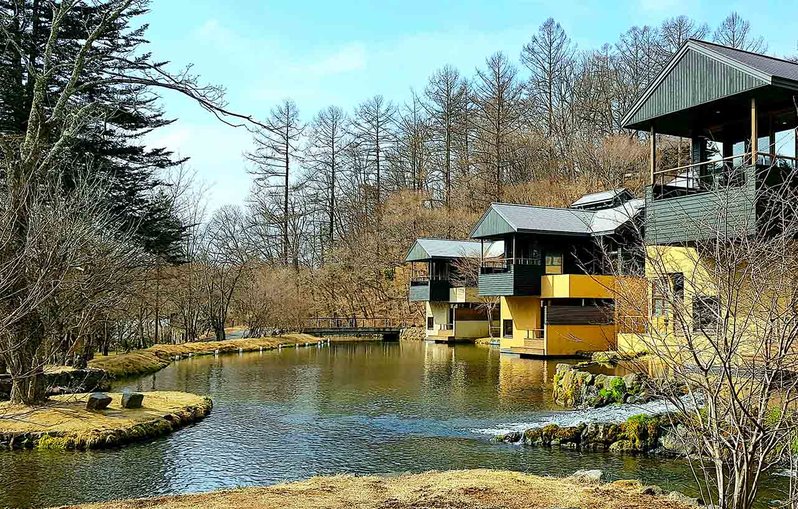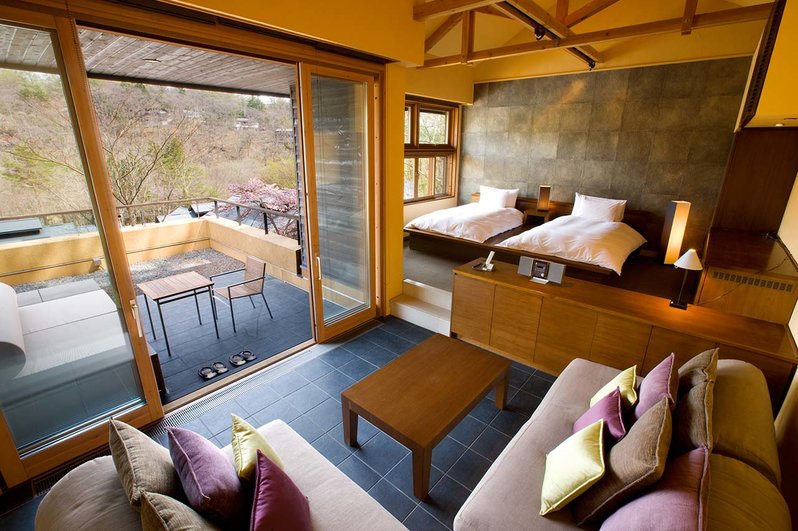 Resort villas
Resort villas
Sprawled over 78,000 square metres, this luxury resort village borders the Karuizawa National Wild Bird Sanctuary Forest located in the Joshinetsu Kogen National Park and the Asama Wildlife Protection Area. Although founded in 2005, the history of HOSHINOYA
Karuizawa can be traced back to 1914 when the current founder's great grandfather opened
the Hoshino Hot Spring Inn at the very same spot as the resort.
The design aesthetic of this eco-friendly flagship property of the Hoshino Resorts Group is
based on the concept of how Japan may have evolved out of its past, but without overly
relying on Western influences. Balancing the needs of a resort village while preserving the
natural environment, it was developed around fir trees where flying squirrels rest and that have existed for generations — the entire estate is zero-emission, powered by
hydroelectricity fueled by the Yukawa river flowing through the premises and geothermal
energy.
 One of the rooms in the resort. Photo from: HOSHINOYA Karuizawa
One of the rooms in the resort. Photo from: HOSHINOYA Karuizawa
Boasting 77 villas, each one a standalone building to provide the look and feel of a private vacation home. The rooms incorporate Japanese architectural elements such as plastered walls and hand-woven washi wallpaper, centred on a raised platform that resembles tatami matting on which sit futon-like beds that’s firm yet enveloping. The bedroom leads to a cosy living space strewn with colourful cushions that open up to a balcony with sweeping views of the surrounds. Resembling a traditional ryokan, the absence of western influences is noticeable; we were perturbed when we couldn't find the luggage rack before finally realising that you’re supposed to pack your stuff into the cupboards as one would at such traditional Japanese inns. In winter, the floor of the room is warmed by the hot spring water, while in summer, there’s a mechanical arm that cranks open the rooftop shutter to let in the natural breeze.
 (Left) Rice terrace deck. (Right) Resort surroundings.
(Left) Rice terrace deck. (Right) Resort surroundings.
The picturesque resort features tiered pavilions on a terraced hill, rivulets cascading down stone walls, connected by tiny bridges and footpaths beneath tree canopies that wind through the surrounding lake that’s mesmerisingly lit in the evening. Designed to captivate, you are encouraged to read at the library while sipping complimentary sparkling wine or sit at an alfresco deck overlooking a rice terrace while savouring mochi grilled over charcoal fire.
 Resort at twilight
Resort at twilight






 Kasuke Restaurant
Kasuke Restaurant

